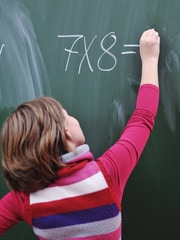5 Ways to Memorize Multiplication Tables Quickly
Multiplication tables are a huge landmark in kid’s mathematical studies. In order to get promoted to higher grades and start solving complex mathematical problems, kids need to be proficient in the art of multiplying numbers.
If you have given your child a good initial multiplication training, it’s going to help them in the long run and be very beneficial in higher grades when they begin working with larger numbers.
Following are the 5 quickest ways with which kids can learn multiplication tables.
1. Skip counting
Skip counting is when you count at intervals of any number you like. If I were to skip count by seven, I would count 7, 14, 21, and so on. You can easily accomplish single-digit multiplication with this method. For example, suppose your teacher asks you to multiply 4 x 7 =. Simply count sevens four times, 7, 14, 21, and 28. 4 x 7 = 28 is the answer.
Go over the skip-counting list until you get to the halfway mark (3, 6, 9, 12, 15, and 18). Allow your child to speak it out loud while pointing to the answers one by one with a finger or a pen. This engages many senses at the same time.
Ask them to repeat the list from memory after they have gone over it a few times.
The mind is similar to muscles in that it requires exercise to grow stronger.
Require them to memorize this list in both ascending and descending order.
Go through the remaining items on the list: 21, 24, 27, 30, 33, 36.
Finally, go over the entire list of answers. Repeat the list UP AND DOWN until it seems natural and effortless.
Time table sheet
| 1 | 2 | 3 | 4 | 5 | 6 | 7 | 8 | 9 | 10 |
| 2 | 4 | 6 | 8 | ||||||
| 3 | |||||||||
| 4 | |||||||||
| 5 | |||||||||
| 6 | |||||||||
| 7 | 49 | ||||||||
| 8 | |||||||||
| 9 | |||||||||
| 10 |
Time table sheets can be used in multiple ways. You can use it to practice and put it in front of your kids so they can keep memorizing it regularly.
2. Adding method
If kids are starting to learn multiplication, tell them to use their previously learned knowledge of addition. Adding similar amounts to the times you want to multiply will work great.
For example
If you want 4×4 then you can add four, four times to get the desired result.
4+4+4+4= 16 4×4=16
You will get the same answers. Once they get fluent with this method make sure they memorize the table. If get stuck they can use this technique to master multiplication.
Learn from easy to hard
Make sure that your child learns the easy multiplication table first before moving on to difficult ones. This way they will not lose interest in the subject and consider it far more difficult than it actually is.
Table of 1, 2, 5, 9, 10, and 11 are comparatively easy to learn. Than move to 3, 4, 6, 7, 8, 12.
For example 2 ×2 =4 and you can always add two to the previous answer to get the next amount. This is only easy until the number gets big enough to learn new ways.
The table to 5 has 5’s and 0’s as the end digit.
Table of 10 is the easiest. Just add zero next to the digit of multiplication.
Once they learn the easier ones and practice to perfection, make sure to slowly and steadily introduce them to hard ones. They will soon discover that not all are easy. More difficult ones simply need some extra attention.
3. Tricks for learning tables
Some multiplication tables can be memorized with easy tricks. Math games can also help children stay engaged in learning.
Take for example the table of 9. You have to write the counting once in ascending order and then in descending order. But when it’s done they must be memorized properly. You will put 9 multiple one is 9 and then 1st digit is in increasing order from 1 to 9 and other digit in decreasing order 9 to 1
For example
9×1=9
9×2=18
9×3=27
9×4=36
9×5=45
And so on to 9×10=90
4. Use of fun toys
The best way to make sure your kids learn multiplication tables is to make it fun. You can use any type of toys, coins, Lego blocks, or even jigsaw puzzles, whichever one is of most interest to your child.
You can teach them multiplication by making pairs of their favorite coins. Then ask them to put pair together and count how many coins are there altogether.
For example, if you are teaching kids table of 3 give them 3 pairs in order to get 3 × 3 =9. This way they will know that combining 3 pairs of 3 will get 9. This will help them learn more effectively and efficiently.
Once kids do this multiple times they will not only enjoy their experience and have a good time, they will learn new multiplication tables as the progress. It’s been shown that
5. Learn by drilling
This is the most widely used way for achieving the goal of learning times tables. Make sure that you encourage your kids to drill three times a day and memorize their multiplication tables. This way they will most quickly remember and respond when certain multiplication questions are asked by the teacher.
Constant drilling is the key here as much as possible.
Make sure that they memorize it in every order whether upward or downward. This way kids will be able to answer in any way possible.
Another way of drilling kids is while listening to their favorite songs. Music has been proven to enhance a child’s memorization even while studying for an exam. Studies show that it’s not the type music that matters. It’s that the person enjoys the music. Rhythm in music through songs is also an effective way to grab attention and help children learn.
A major part of the times table learning process that kids are constantly quizzed. If they memorize a table, quiz them regularly to perfect their memory.
Rewarding kids for hard work is also a great way to ensure they stay enthusiastic and ready for upcoming texts and quizzes. Incorporating pictures like your child’s favorite animals to visually enhance multiplication tables. This helps to awaken all sense for learning and make the experience much more fun and memorable.





